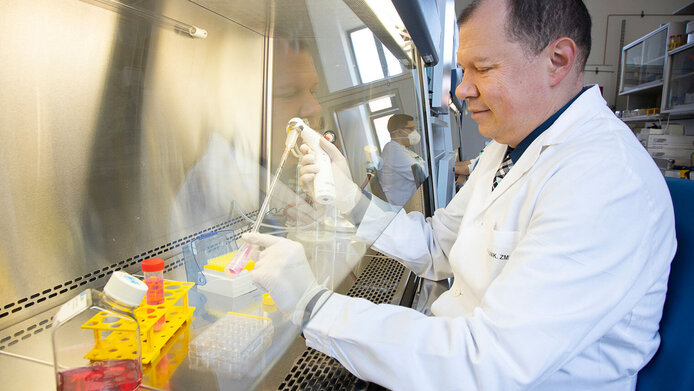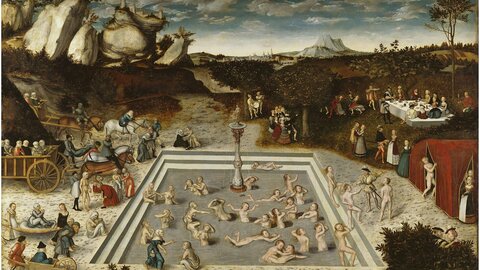New approaches for treating periodontitis

As a gateway into the body, the oral cavity is colonised by a particularly large number of different bacteria. Most of them are beneficial for humans, and the immune system is well equipped to defend the body against those that are less benign. However, if certain bacteria become predominant, a weakened immune system is no longer able to fight the pathogens. This condition can result in periodontitis, which in turn can lead to chronic inflammation of the gums and, in the absence of treatment, even tooth loss. Thanks to a Vienna-based research team, one more jigsaw piece has been added to the big picture of interactions underlying this complicated inflammatory process.
A new angle
“We know that so-called dental mesenchymal stem cells (MSCs) play an essential role,” says Oleh Andrukhov from the Vienna University Clinic of Dentistry. “So far, they were mainly considered a useful tool for tissue regeneration. But they also have the ability to influence immune cells. In other words: they have an immunomodulating effect.” While recent studies have already suggested that MSCs have different immunomodulatory properties, these differences have never been systematically investigated. This issue has now been addressed by Oleh Andrukhov and his team of postdocs, PhD and Master's students in the context of a five-year project funded by the Austrian Science Fund FWF. They also developed the hypothesis that the interaction of dental MSCs with immune cells plays an essential role in periodontitis, and they explored the influence of vitamin D3 on this interaction, since: “It has long been assumed that vitamin D3 is a risk factor for periodontitis.”
Research findings
For their investigations, the researchers isolated blood cells from test subjects with good dental and overall health, as well as mesenchymal stem cells (progenitor cells) from extracted (pulled) teeth. “We developed our own model in order to examine the interaction between stem cells and immune cells and vitamin D3,” explains Andrukhov, who heads the Competence Center for Periodontal Research at the Vienna University Dental Clinic. Andrukhov and his team found a perfectly balanced system. “There is a constant, reciprocal interaction between immune cells and dental stem cells.” While normally self-balancing, this interaction ultimately depends on the local conditions in the oral cavity, above all the presence of pro-inflammatory cytokines (signalling molecules of the immune cells). The cytokine production of the immune cells activates the dental MSCs, whereas dental MSCs suppress the activity of immune cells, which leads to lower cytokine production. Keeping this interaction in balance could be an essential factor for the progression of periodontitis and for the regeneration of dental tissue.
Influence of vitamin D3
The data have also shown that vitamin D3 influences this balanced interaction between immune cells and dental MSCs in multiple ways. On the one hand, vitamin D3 inhibits the activity of various immune cells and thereby reduces the production of pro-inflammatory cytokines. On the other hand, vitamin D3 also inhibits the immunomodulatory activity of dental MSCs. These properties of vitamin D3 are in turn inhibited by bacterial factors and regulated by cytokines. Hence, vitamin D3 influences local conditions while its bioactivity is in turn modulated by these conditions.
Follow-up project launched
These findings suggest that the administration of higher doses of vitamin D3 could act as an adjunctive therapy for periodontitis and that the effectiveness of vitamin D3 could be improved by changing the local conditions. “However, we still need to find out what the optimal conditions are,” notes Andrukhov. At any rate, the results open up a new perspective for future research projects. “We have launched a follow-up project to explore the question of which subpopulation of stem cells is best suited for therapeutic use. This will allow us to bridge the gap from basic research to clinical application.” In the longer term, Oleh Andrukhov's aims to set up and develop his own research group. “The full picture of the processes in the mouth is very complicated, but at the same time very elegant. I really enjoy doing research in this field and finding solutions to the challenges of dentistry.“
Personal details
Oleh Andrukhov is a biophysicist and cell biologist. His studies and his research took him to the Bogomoletz Institute of Physiology in Kyiv, the Department of Cell Biology at the University of Salzburg and the Ludwig Boltzmann Institute of Traumatology in Vienna. Since 2008, Andrukhov has been working and researching at the University Clinic of Dentistry of the Medical University Vienna where he has been heading the Competence Center for Periodontal Research since 2019. His basic-research project “Vitamin D and immunomodulation by mesenchymal stem cells” (2016–2021) received EUR 315,000 in funding from the Austrian Science Fund FWF.
Publications
Blufstein A., Behm C., Kubin B., Gahn J., Moritz A., Rausch-Fan X., Andrukhov O.: Effect of vitamin D3 on the osteogenic differentiation of human periodontal ligament stromal cells under inflammatory conditions, in: Journal of Periodontal Research 2021
Behm C., Blufstein A., Gahn J., Kubin B., Moritz A., Rausch-Fan X., Andrukhov O.: Pleiotropic effects of vitamin D3 on CD4+ T lymphocytes mediated by human periodontal ligament cells and inflammatory environment, in: Journal of Clinical Periodontology 2020
Behm C., Blufstein A., Gahn J., Nemec M., Moritz A., Rausch-Fan X., Andrukhov O.: Cytokines differently define the immunomodulation of mesenchymal stem cells from the periodontal ligament, in: Cells 2020
Andrukhov O., Behm C., Blufstein A., Rausch-Fan X.: Immunomodulatory properties of dental tissue-derived mesenchymal stem cells: Implication in disease and tissue regeneration, in: World Journal of Stem Cells 2019





